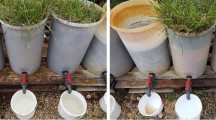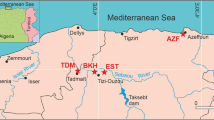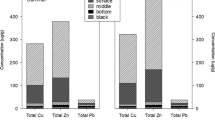Abstract
Sewage sludge can be a suitable, organic-rich substrate to promote vegetation of sulfide-mine tailings, but it may contain contaminants, that, when oxidized, can adversely affect underlying groundwater systems. The geochemical impact of a surface application of 12,000 metric tons of anaerobically-digested sewage sludge on the groundwater quality of a remediated sulfide-tailings impoundment in northern Sweden was evaluated to determine if sludge-borne metals and nitrate were released to the underlying groundwater system. Two years of data from a field-scale groundwater monitoring programme initiated just before the sludge application was compared to groundwater data from 1998 to 2006. Grass was successfully established within 2 years. However, until that occurred, elevated concentrations of sludge-borne metals (Cu, Ni, Pb, Zn) were released to the underlying groundwater. In addition, the release of nitrate likely exacerbated metal concentrations by providing an oxidant for pyrite in the underlying tailings. The release was periodic due to the establishment of the grass, which immobilized metals and nitrate in the sludge. Metals bound as organo-metallic complexes, due to dissolved organic carbon released from the sludge, migrated across the tailings impoundment. Model simulations indicate that the plume will take 6 years to exit the groundwater environment. Though the impacts are relatively short-term, this type of application should be reconsidered in the future.
Zusammenfassung
Klärschlamm kann ein passendes, an organischen Stoffen reiches Substrat sein, um die Vegetation auf Sulfid-reichen Tailings-Materialien zu fördern. Der Klärschlamm kann aber auch Kontaminationen enthalten, die im Falle einer Oxidation darunterliegende Grundwassersysteme negativ beeinflussen können. Der geochemische Einfluss einer Oberflächenaufbringung von 12 000 t anaerob ausgefaulten Klärschlamms auf die Grundwasserqualität eines sanierten Sulfid-Tailings-Beckens in Nordschweden wurde untersucht. Es wurde geprüft, ob aus dem Klärschlamm stammende Metalle oder Nitrat in das unterliegende Grundwassersystem abgegeben wurden. Daten aus einer zweijährigen Datenreihe aus Grundwasseruntersuchungen, die unmittelbar vor der Schlammausbringung begonnen wurden, wurden mit Grundwasserdaten aus den Jahren 1998–2006 verglichen. In den zwei Jahren konnte ein guter Aufwuchs von Gras erreicht werden. Seither wurden jedoch erhöhte Konzentrationen von Metallen aus dem Klärschlamm (Cu, Ni, Pb, Zn) in das unterliegende Grundwasser abgegeben. Außerdem erhöhte die Abgabe von Nitrat wahrscheinlich Metallkonzentrationen, indem das Nitrat als Oxidationsmittel für Pyrit in den Tailings-Materialien wirkte. Die Auswaschungen traten periodisch auf durch das Aufwachsen des Grases, das Metalle und Nitrat im Schlamm immobilisierte. Metalle migrierten durch die Tailings-Materialien, wenn sie durch aus dem Klärschlamm stammende organische Verbindungen als Metall-organische Komplexe gebunden waren. Modellsimulationen zeigten, dass die Kontaminationswolke sechs Jahre brauchen wird, um das Grundwasser zu verlassen. Trotz der relativ kleinen Zeit der negativen Beeinflussung des Grundwassers sollte für zukünftige Vorhaben die Anwendung von Klärschlamm wie im untersuchten Fall überdacht werden.
Resumen
El lodo de aguas residuales es un sustrato rico en compuestos orgánicos que es adecuado para promover la vegetación en colas de minas sulfuradas aunque puede contener contaminantes que, cuando son oxidados, pueden afectar negativamente las aguas subterráneas subyacentes. Se evaluó el impacto geoquímico de la aplicación superficial de 12.000 toneladas métricas de lodo de aguas residuales digerido anaeróbicamente sobre la calidad del agua subterránea de un dique de colas sulfuradas remediado en el norte de Suecia. Esta evaluación pretendía determinar si metales y nitratos habían sido liberados a las aguas subterráneas subyacentes. Los datos tomados durante dos años mediante un programa de monitoreo de agua subterránea a escala de campo que fue iniciado justo antes de la aplicación del lodo, fue comparado con datos obtenidos entre 1998 y 2006. La hierba fue exitosamente instalada dentro de los dos años. No obstante, hasta que eso ocurrió, elevadas concentraciones de metales (Cu, Ni, Pb, Zn) fueron liberados al agua subterránea subyacente. Además, la liberación de nitrato incrementó las concentraciones de metales al proveer un oxidante para la pirita presente en las colas subyacentes. La liberación fue periódica debido a la hierba que inmoviliza metales y nitratos en el lodo. Metales unidos como complejos órgano metálicos debido al carbono orgánico disuelto que se liberó del lodo, migraron a través del dique de colas. Las simulaciones a través de modelos indican que la pluma tomará 6 años para salir del ambiente de aguas subterráneas. Aunque los impactos son relativamente de corto tiempo, este tipo de aplicaciones debería ser reconsiderada en el futuro.
摘要
污水污泥是一种理想的富含有机质培养基,能够用以提高富含硫化物尾矿库的植被覆盖率。但是,污水污泥往往含有污染物;当其被氧化时,对地下水水质产生负面影响。文章研究了12000吨厌氧菌致分解污水污泥盖层对瑞典北部已修复硫化物尾矿库地下水水质的地球化学影响,识别了污水污泥是否将其携带的金属离子和硝酸盐释放到下伏地下水系统中。文章对比了污泥盖层铺设前已起动的地下水现场监测计划的前两年数据与1998-2006年地下水监测数据。在两年时间内,成功完成尾矿库草皮覆盖。然而,由污水污泥产生的高浓度重金属离子(Cu, Ni, Pb, n)已经释放到下伏地下水系统中。污水污泥释放的硝酸盐为下伏尾矿里的黄铁矿提供了氧化剂,使重金属浓度进一步提高。草皮可以固定污泥里的重金属和硝酸盐,草皮覆盖使金属离子释放呈现周期性特征。同时,由于污泥能够释放溶解有机炭,金属离子被束缚于有机金属络合物中而运移、穿过尾矿库。模拟结果表明,污染羽流将用六年时间流出地下水系统。虽然此类污染时间较短,但是应该慎重考虑污泥盖层的未来应用。






Similar content being viewed by others
References
Ahlberg G (2006) Ageing of sewage sludge—some physical and chemical properties in relation to landscaping. Doctoral Thesis, Göteborg University, Sweden
Ahlberg G, Gustafsson O, Wedel P (2006) Leaching of metals from sewage sludge during one year and their relationship to particle size. Environ Pollut 144:545–553
Alakangas L (2006) Sulphide oxidation, oxygen diffusion and metal mobility in sulphide-bearing mine tailings in Northern Sweden. PhD Thesis, Luleå University of Technology, Sweden
Alakangas L, Nason PA (2010) Declining element concentrations in groundwater after remediation in sulphide-rich tailings at Kristineberg, northern Sweden. In: Wolkersdorfer C, Freund A (Eds), Proceedings of Symposium International Mine Water Association, Water and Innovative Thinking, Sydney, pp 323–326
Andres NF, Francisco MS (2008) Effects of sewage sludge application on heavy metal leaching from mine tailings impoundments. Bioresour Technol 99:7521–7530
Appelo CAJ, Postma D (2005) Geochemistry, groundwater and pollution, 2nd edn. In: Balkema AA, Leiden
Ashworth DJ, Alloway BJ (2004) Soil mobility of sewage sludge-derived dissolved organic matter, copper, nickel and zinc. Environ Pollut 127:137–144
Axelsson C-L, Karlkvist L, Lintu Y, Olsson T (1986) Gruvindustrins restproduktupplag—fältundersökningar med vattenbalansstudie i Kristineberg. Uppsala Geosystem AB [in Swedish, with summary in English]
Axelsson C-L, Ekstav A, Holmén J, Jansson T (1991a) Efterbehandling av sandmagasin i Kristineberg, Hydrogeologiska förutsättningar för åtgärdsplan: Lakvattenbalanser och vittringsbegränsande åtgärder. Report [in Swedish]
Axelsson C-L, Ekstav A, Jansson T (1991b) Provtagning av sand och grundvatten i sand-magasin 1, 1B och 2 Kristineberg—Fältrapport. Golder Geosystems AB. Report 917–1687 [in Swedish]
Carlsson E (2002) Sulphide-Rich tailings remediated by soil cover—evaluation of cover efficiency and tailings geochemistry, Kristineberg, northern Sweden. PhD Thesis, Luleå University of Technology, Sweden
Carlsson E, Ohlander B, Holmstrom H (2003) Geochemistry of the infiltrating water in the vadose zone of a remediated tailings impoundment, Kristineberg mine, northern Sweden. Appl Geochem 18:659–674
Christensen JB, Christensen TH (2000) The effect of pH on the complexation of Cd, Ni and Zn by dissolved organic carbon from leachate-polluted groundwater. Water Res 34:3743–3754
Corrège O, Carlsson E, Öhlander B (2001) Geochemical investigations of the groundwater in sulphide-bearing tailings remediated by applying till cover. In: Proceedings of Symposium Securing the Future: International Conference on Mining and the Environment, Skellefteå, Sweden, pp 97–114
Cravotta CA (1998) Effect of sewage sludge on formation of acidic ground water at a reclaimed coal mine. Groundwater 36:9–19
Eriksson J (2001) Concentrations of 61 trace elements in sewage sludge, farmyard manure, mineral fertiliser, precipitation and in soil and crops. Report 5159:69, Swedish Environmental Protection Agency, Stockholm
Evanylo GK (ed) (1994) Mineralisation and availability of nitrogen in organic waste-amended mid-Atlantic soils. Chesapeake Research Consortium Inc, Edgewater
Fletcher P, Beckett PHT (1987) The chemistry of heavy-metals in digested sewage sludge. 2. Heavy-metal complexation with soluble organic matter. Water Res 21:1163–1172
Forsberg SL (2008) Reclamation of copper mine tailings using sewage sludge. PhD Thesis, Swedish University of Agricultural Sciences, Sweden
Forsberg LS, Gustafsson JP, Kleja DB, Ledin S (2008) Leaching of metals from oxidising sulphide mine tailings with and without sewage sludge application. Water Air Soil Pollut 194:331–341
Fytili D, Zabaniotou A (2008) Utilization of sewage sludge in EU application of old and new methods—a review. Renew Sust Energ Rev 12:116–140
Garcia-Gil JC, Plaza C, Senesl N, Brunetti G, Polo A (2007) Effects of long-term sewage sludge amendment on the composition, structure and proton binding activity of soil fulvic acids. Clean Soil Air Water 35:480–487
Gotthardsson J, Sundberg Å (2005) Mine site reclamation using products from the pulp industry. In: Proceedings of Symposium Securing the Future, International Conference on Mining and the Environment, Metals and Energy Recovery
Gustafsson JP (2001) Modeling the acid-base properties and metal complexation of humic substances with the stockholm humic model. J Colloid Interface Sci 244:102–112
Hallberg RO, Granhagen JR, Liljemark A (2005) A fly ash/biosludge dry cover for the mitigation of AMD at the falun mine. Chem Der Erde-Geochem 65:43–63
Hanæus Å, Mattsson E (2009) Remedial measures taken at the Falun Mine site, Sweden. In: Proceedings of Symposium Securing the Future, 8th International Conference on Acid Rock Drainage, Skellefteå, Sweden
Höglund LO, Herbert RB, Lövgren L, Öhlander B, Neretnieks I, Moreno L, Malmström M, Elander P, Linvall M, Lindström B (2005) MiMi—performance assessment–main report: MiMi report 2003:3. In: Höglund LO, Herbert RB (eds), MiMi Print, Luleå, Stockholm
Holmström H, Salmon UJ, Carlsson E, Petrov P, Öhlander B (2001) Geochemical investigations of sulfide-bearing tailings at Kristineberg, northern Sweden, a few years after remediation. Sci Total Environ 273:111–133
INAP (2009) Global Acid Rock Drainage (GARD) Guide. www.gardguide.com
Karlsson S, Allard B, Bäckström M (2010) Weathering mechanisms and composition of effluents from a sulphide mine waste deposit after covering—twenty years of field data. In: Wolkersdorfer C, Freund A (eds), Proceedings of Symposium International Mine Water Association, Water and Innovative Thinking, Sydney, pp 359–362
Lindvall M, Lindahl L, Eriksson N (1997) The reclamation project at the Saxberget mine, Sweden. In: Proceedings of 4th International Conference on Acid Rock Drainage, Vancouver, pp 1389–1400
Lindvall M, Eriksson N, Ljungberg J (1999) Decommissioning at Kristineberg mine, Sweden. In: Proceedings of 1999 Symposium Mining and the Environment, Sudbury, pp 855–862
Lottermoser B (2010) Mine wastes, characterization, treatment and environmental impacts. Springer, Berlin
Marklund S (1997) Dewatering of wastewater sludge by natural air drying. Licentiate Thesis, Luleå University of Technology, Sweden
Neuschütz C (2009) Phytostabilization of mine tailings covered with fly ash and sewage sludge. PhD Thesis, Stockholm University, Sweden
Neuschütz C, Isaksson K, Lundmark L, Gregor M (2009) Evaluation of a dry-cover treatment consisting of vegetation, sewage sludge and fly ash. In: Proceedings of Symposium Securing the Future, 8th International Conference on Acid Rock Drainage, Skellefteå, Sweden, pp 1–9
Pichtel JR, Dick WA, Sutton P (1994) Comparison of amendments and management-practices for long-term reclamation of abandoned mine lands. J Environ Qual 23:766–772
Porse E (2002) Jordartsgeologiska egenskaper hos avloppsslam. Project Work, University of Gothenberg, Report B340 [in Swedish]
Schroder JL, Zhang H, Zhou D, Basta N, Raun WR, Payton ME, Zazulak A (2008) The effect of long-term annual application of biosolids on soil properties, phosphorus, and metals. Soil Sci Soc of Am J 72:73–82
Statistics-Sweden (2008) Discharges to water and sewage sludge production in 2006. Publ in collaboration with the Swedish Environmental Protection Agency. http://www.scb.se/templates/Publikation__232141.asp
Torstensson BA (1984) A new system for groundwater monitoring. Groundwater Monit Rem 4:131–138
Werner K, Carlsson E, Berglund S (2001) Oxygen- and water fluxes into a soil-cover remediated mill tailings deposit: Evaluation of field data from the Kristineberg mine site, Northern Sweden. In: Proceedings of Symposium Securing the Future, International Conference Mining and the Environment, Skellefteå, Sweden, pp 896–905
Acknowledgments
This study was funded by Georange, which distributes EU-structural funds in Sweden and was conducted within the framework of the Centre of Advanced Mining and Metallurgy (CAMM) at the Luleå University of Technology. The authors express further gratitude to New Boliden AB for providing assistance and access to the site at Kristineberg Mine and to Bert-Sive of Bergteamet, who provided further field assistance. ALS Scandinavia is acknowledged for providing sample analyses. Finally, thanks goes to Milan Vnuk for help preparing the figures and Angela Lundberg for assistance with the groundwater intepretation.
Author information
Authors and Affiliations
Corresponding author
Rights and permissions
About this article
Cite this article
Nason, P., Alakangas, L. & Öhlander, B. Impact of Sewage Sludge on Groundwater Quality at a Formerly Remediated Tailings Impoundment. Mine Water Environ 33, 66–78 (2014). https://doi.org/10.1007/s10230-013-0244-6
Received:
Accepted:
Published:
Issue Date:
DOI: https://doi.org/10.1007/s10230-013-0244-6




